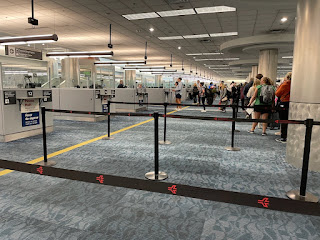When and How to Travel on Spirit (or Other Budget Airlines)
My husband and I were dating long distance for ~2 years and then we planned our
wedding back in Houston while living in Detroit. There's no way I would have
been able to afford traveling back and forth across the country every month, or
even every other month, without saving money by flying on Spirit. After 3.5
years of frequent practice, I have flying on Spirit down to a science that
translates to pretty much any US budget airline. We've all heard the horror
stories along with the angry "I'll never fly *insert budget airline here*
again!!" But, honestly, it's really not that bad if you follow a couple of
ground rules - and I'm here to let you know what those rules are.
First and foremost, you need to know that budget airlines make their
money by charging for everything separately. That means you will
only save money by minimizing your purchases over the base fares, and you have
to understand when booking a budget airline makes sense in order to do that.
For a lot of trips, you can rule it out immediately and avoid an inevitable bad
outcome. Second, you'll need to know what and how to pack in order to make the
most of your trip. And finally, start your trip off on the right foot by knowing
what to expect during your flight.
So, when
does it make sense? The short answer is when you don’t need to pay for a bag. Both
carry-on and checked bags cost money on budget airlines. Once you add the amount
you would pay for bags onto the base fare, you’re usually paying the same amount
you would for a non-budget airline, but without any of the perks! To avoid a
bag that comes with a fee, make sure you can fit everything you need in your “personal
item”.
Each budget
airline has size restrictions for personal items posted on their website. It
won’t be huge, but the dimensions will be large enough for you to bring a small
duffel bag or a normal sized backpack. At the boarding gate, there is a bin
that the employees can have you prove your bag fits into. If it doesn’t, the
airline will charge you even more than you would have paid for a checked or
carry-on bag. Also, you only get one personal item for free. If you have
two bags of any kind with you, the airline will force you to consolidate them
into a single item that fits into the bin, or charge you an extraordinary
amount of money for the second item. That includes fanny packs, crossbody
purses, totes, laptop bags, etc.
The
challenge then becomes fitting everything you need into your personal item. For
trips lasting longer than 5 days, I’ve found that is usually impossible. And
the colder the destination is, the shorter the trip duration is that you can
reasonably pack for. For example, a trip to Florida won’t require many large
clothes. You’ll likely be packing shorts, tank tops, flip flops, and bathing
suits that don’t take up much space. You probably don’t need a big jacket while
you’re there either. On the other hand, visiting Michigan in January might require
you to wear a few layers of clothes the entire time to be comfortable, and only
a couple of sweaters or pairs of pants will fit in a small bag…. The moral of
the story is that you can certainly make short trips to cold places with only a
personal item, but flying budget airlines is really best (and easiest) for
short trips to warmer destinations.
What to pack
is then pretty straightforward. To minimize the size of what goes in your bag, plan
on wearing all your largest items on the plane. That means you need to wear
your largest shoes, your biggest pants and top, and all of the jackets you want
to have for your trip. Maybe strategically layer the tops that you wear to get
a couple items instead of just one. Don’t worry, if you want, you can actually
carry your jackets without the airlines charging you extra for them, because
they are flexible and don’t have to take up space in the overhead bin. Then you
should be able to fit up to 5 outfits in your bag, something to sleep in, a
small assortment of travel size toiletries, maybe a fanny pack or purse to get
out at your destination, a phone charger, a few accessories such as sunglasses
or a hat, an alternate pair of flat shoes such as sandals or flip flops, and
some sort of entertainment such as a laptop, book, and/or headphones. The only
caveat here is that you’ll likely need to wear the same or a very similar
outfit on the flight home as you did on the way to your destination. If you did
in fact wear all your largest items on the plane, it’s unlikely you’ll be able
to stuff them all into your bag at the end of the trip in favor of a different
outfit.
You should
also bring an empty water bottle that you can fill up and take on the flight
after you get through security and some snacks from home, because when I say
that the airline charges for everything, that includes drinks (even water!) and
snacks on the plane, seats if you want to choose them yourself, shortcut
boarding, and even printing your boarding pass at the airport. Again, paying
for all of these things defeats the purpose of flying a budget airline in the
first place.
If you don’t
choose a seat when you buy your flight or check in, a random one will be
assigned to you. As long as you book tickets for multiple people through a
single reservation the random seats are almost always together. To ensure that’s
the case, check in for your flight as soon as the check-in window opens – that way
there are still plenty of unassigned seats for the computer to choose from that
are in the same area. If your seats end up being apart for some reason, people
are generally happy to move so that you can sit with your family, especially if
you are trading your aisle or window seat for their middle seat!
Expect the
seats to be smaller than they are on non-budget airlines, with less leg room.
The exact dimensions can usually be pulled up very easily on Google, or through
the airline’s website. Also don’t expect to lean back during the flight; typically,
that feature doesn’t even exist.
When you check in, make sure to print the boarding pass then, email it to your phone, or get an electronic boarding pass through the airline’s app to avoid the boarding pass printing fee. And finally, don’t spend money on shortcut boarding. People that paid for carry-on bags automatically get to board the plane first and it’s not something that is recognized by airport security, so shortcut boarding doesn’t really get you much. Your money is much better spent on TSA pre-check, but that’s a different post!






Comments
Post a Comment